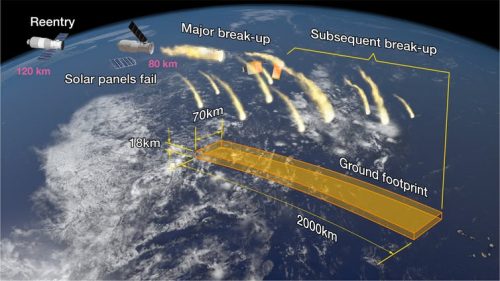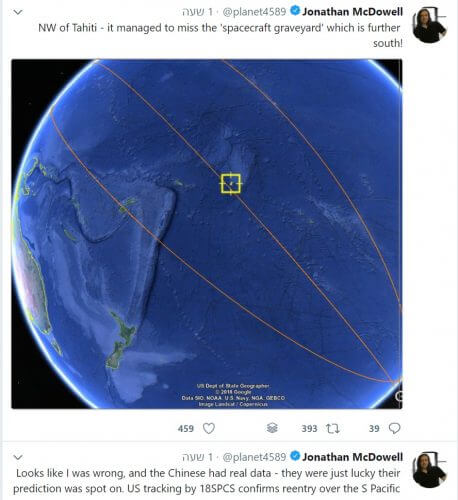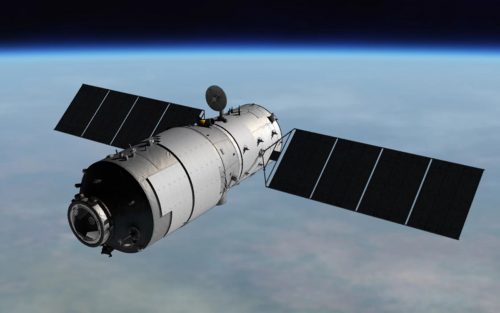The event once again illustrated the need to address the space debris problem * Tiangong-1 burned up in the atmosphere, but landed thousands of kilometers north of the "spacecraft graveyard" that stretches across the South Pacific Ocean


The Chinese space station Tiangong-1 crashed tonight close to the scheduled time (00:16 GMT, 03:16 Israel time), northwest of the Tahiti Islands in the northern South Pacific Ocean. Thus ended their long days of waiting for the uncontrolled fall, Although the preliminary assessment was that the danger that parts of the station would be harmed by humans was slight in light of the emptiness of large areas on Earth (oceans, deserts, high mountains).
The assessment at NASA and other space agencies was that most of the parts of the station, which weighed 8.5 tons, burned up in the atmosphere and, as mentioned, the few parts that remained, if any, landed in the heart of the ocean. However, the fall occurred far to the north of the area known as the "Space Debris Graveyard" (see expansion below).
Tiangong-1 was a prototype of the space station program of China's Manned Space Program Office. It was used to demonstrate China's ability to maintain a space station and maneuver a docking to it in preparation for the construction of a large space station that will be permanently manned, like the International Space Station, as part of China's ambitious space program. The station itself was not manned when it was launched, but it was equipped with docking facilities and was visited by two crews. Three astronauts were launched to it on the Shenzhou 9 spacecraft launched on June 16, 2012, including the first Chinese astronaut, fighter pilot Liu Yang. The crew members spent 11 days at the station and completed two dockings - one controlled by a computer and the other - by crew members with guidance from the ground. The second crew launched on June 11, 2013 consisted of three astronauts and spent 13 days on the station completing the first maintenance of an in-orbit space station by China and performing additional docking checks.
The Chinese space station Tiangong-2, which replaced Tiangong 1, was launched in September 2016 and was already visited by a manned crew during 2017. It is estimated that China will launch a modular space station that will remain in space for many years in 2022. China is prevented from participating in the International Space Station program due to the US's opposition to its exposure to advanced technologies .
(This section is based on an article published on the website THE CONVERSATION by Prof. Brad Tucker, an astrophysicist from the Australian National University)
According to Tucker, the area halfway between New Zealand and South America in the Pacific Ocean is one of the least populated places on Earth. This is the ideal location to target large parts of spacecraft so that the risk to humans or animals is minimal, of course if the spacecraft intended to fall is controlled from the ground.
"While most of these objects will break up into smaller pieces, choosing a remote location will further reduce the risk of being hit by them. On the bottom of the Pacific Ocean in this vast area are scattered hundreds of pieces of launcher boosters, many satellites and even the Russian space station Mir, which crashed east of the Fiji Islands in March 2001."
"When you look at the maps of intentional smashing of satellites and space debris, you see that most of them pass over Australia and New Zealand. The reason for this is that the entry into the atmosphere begins when the spacecraft is at an altitude of 80-100 kilometers, and from the moment of entry, the process of disintegration and burning in the atmosphere, as well as the fall of the large parts, takes about 15-20 minutes, which causes the potential fall area to have an area of hundreds or even thousands in width kilometers. Therefore, in order to meet the goal of crushing in the South Pacific, the process must begin over Australia and New Zealand."
"But there is one important feature that makes Tiangong-1 different: It went out of control, according to China's space agency. If you visited Western Australia around 1979, you might have come across the remains of the American space station Skylab, parts of which fell near the southern city of Esperance."
"Nowadays most space missions include a plan to re-enter the space object into the atmosphere. This was not always the case. Skylab didn't have a good plan. The station was planned for a life period of nine years and a clear maneuver for entering at a certain point was not prepared ahead of time. When it became clear that Skylab was going to crash and it was not clear where the panic was. In Brussels, for example, they prepared for action alarm sirens designed to warn against an air attack."

"After it hit the ground, Esperance County fined NASA $400 for littering the county. The fine was finally paid in 2003, not by NASA, but by an American radio host and his listeners who raised the funds."
"When China announced in 2016 to the United Nations Office for Outer Space Affairs that Tiangong 1 was out of control and it would not be possible to control its entry into the atmosphere, and caused the field of space debris danger to rise to awareness, despite this, many media outlets and the general public panicked."
no panic!
Prof. Tucker explains that every day hundreds of tons of waste, human and natural (i.e. meteors), enter the atmosphere. Even those who survived the entry into the atmosphere do not pose a great risk. Most of the Earth, from the oceans to the deserts, is uninhabited, so the danger of humans being harmed is small. "The total area of the earth is over 500 million square kilometers. Even if a piece of space debris leaves a 1,000 square kilometer debris field, that's only 0.0002% of the Earth's surface. In fact, the Aerospace Corporation has calculated that the chance of being hit by debris from the Tiangong-1 spacecraft is a million times smaller than the chance of winning the lottery.
"However, what do we do to prevent such cases? Of course, we can do a lot to reduce space debris. For example reuse of launchers. The launchers and their engines are the largest source of space debris and occasionally parts of them enter the atmosphere and burn up. About two months ago there was great excitement surrounding the launch of the Falcon 9 Heavy launcher by SpaceX. One of the reasons for the excitement was that these launchers can land safely, which allows them to be used for another launch, and not become another piece of waste."
"The revolution of small satellites will actually enable a reduction of space debris. In addition to the fact that they are cheap and can be built quickly, at the end of their life they can completely disintegrate in the atmosphere and the risk of large pieces falling to the ground is avoided."
In conclusion, Prof. Tucker writes that today many efforts are being made to combat space debris, starting with satellites that will be transported in orbit and clean the space and ending with laser systems that will be launched from the Earth towards such waste blocks and break them up.
Explanation of the crash of the Chinese space station Tiangong 1. Aerospace Corp
More of the topic in Hayadan:
